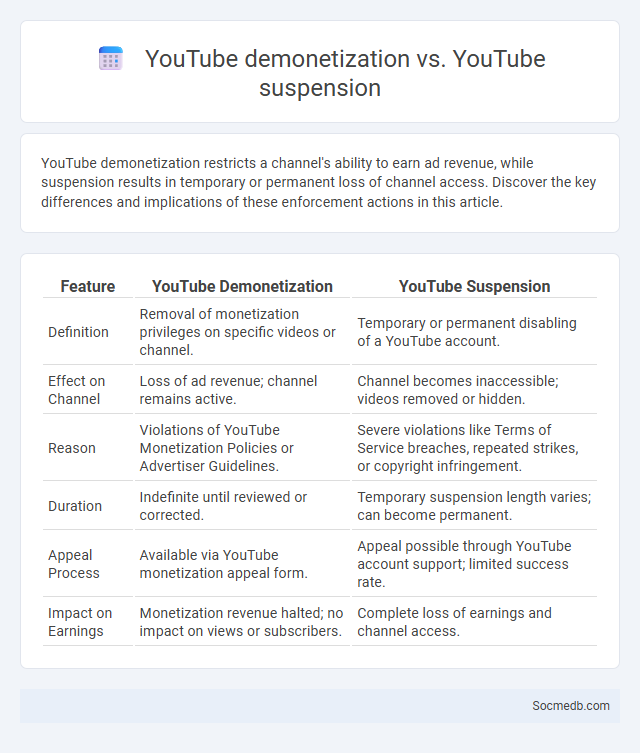
Photo illustration: YouTube demonetization vs YouTube suspension
YouTube demonetization restricts a channel's ability to earn ad revenue, while suspension results in temporary or permanent loss of channel access. Discover the key differences and implications of these enforcement actions in this article.
Table of Comparison
| Feature | YouTube Demonetization | YouTube Suspension |
|---|---|---|
| Definition | Removal of monetization privileges on specific videos or channel. | Temporary or permanent disabling of a YouTube account. |
| Effect on Channel | Loss of ad revenue; channel remains active. | Channel becomes inaccessible; videos removed or hidden. |
| Reason | Violations of YouTube Monetization Policies or Advertiser Guidelines. | Severe violations like Terms of Service breaches, repeated strikes, or copyright infringement. |
| Duration | Indefinite until reviewed or corrected. | Temporary suspension length varies; can become permanent. |
| Appeal Process | Available via YouTube monetization appeal form. | Appeal possible through YouTube account support; limited success rate. |
| Impact on Earnings | Monetization revenue halted; no impact on views or subscribers. | Complete loss of earnings and channel access. |
Understanding YouTube Demonetization: What It Means
YouTube demonetization refers to the removal or restriction of ads on videos that violate the platform's advertising policies, impacting creators' revenue streams. Common causes include content deemed inappropriate, copyrighted material, or failure to meet YouTube's advertiser-friendly guidelines. Understanding the nuances of demonetization helps creators adapt their content strategies to maintain monetization and channel growth.
YouTube Suspension: Causes and Consequences
YouTube suspension often results from violations of community guidelines, such as copyright infringement, hate speech, or spamming, leading to temporary or permanent channel disablement. The consequences of suspension include loss of revenue, diminished audience reach, and damaged creator reputation, which can hinder future content opportunities. Understanding these causes and effects is crucial for maintaining compliance and sustaining a successful YouTube presence.
Key Differences: Demonetization vs Suspension
Demonetization on social media involves removing or limiting a user's ability to earn revenue from their content, often due to policy violations related to copyright or community guidelines, while allowing content to remain accessible to viewers. Suspension refers to the temporary or permanent disabling of a user's account, restricting access entirely and preventing content posting or interaction across the platform. Both impact user activity but differ significantly in scope, with demonetization targeting monetization privileges and suspension affecting overall account functionality.
Common Triggers for Demonetization on YouTube
YouTube demonetization commonly occurs due to violations of community guidelines, including inappropriate language, hate speech, or harmful content. Videos that feature copyrighted material without permission or contain misleading metadata often trigger automatic demonetization. Understanding these triggers helps you create compliant content, ensuring your channel remains eligible for monetization and revenue generation.
How Suspension Impacts Your YouTube Channel
Suspension of a YouTube channel halts content uploads, disables live streaming, and restricts access to analytics, significantly impairing audience engagement and growth. This interruption often results in reduced subscriber retention and loss of ad revenue, directly affecting a creator's income and channel credibility. The reinstatement process can be lengthy, requiring compliance with YouTube's community guidelines and appeals, making timely resolution critical for channel sustainability.
Demonetization vs Suspension: Impact on Creators’ Revenue
Demonetization limits creators' ability to earn ad revenue by restricting monetizable content without removing accounts, often resulting in reduced income but maintained presence. Suspension temporarily or permanently disables accounts, causing complete revenue loss and disconnecting creators from their audiences. Both actions significantly disrupt creators' financial stability, but suspension imposes a more immediate and severe impact on revenue streams.
Policy Violations: What Leads to Demonetization or Suspension?
Social media platforms enforce strict policy violations such as hate speech, misinformation, copyright infringement, and harassment, which commonly lead to demonetization or suspension of accounts. Automated detection systems combined with user reports help identify content that breaches community guidelines, resulting in penalties like reduced monetization or temporary to permanent account bans. Maintaining compliance with platform-specific rules ensures content creators avoid disruptive consequences and sustain their revenue streams.
Steps to Recover from YouTube Demonetization
You can recover from YouTube demonetization by thoroughly reviewing YouTube's community guidelines and content policies to identify content issues. Next, appeal the demonetization decision through the YouTube Partner Program dashboard by providing clear evidence that your videos comply with all monetization standards. Focus on enhancing your channel's quality by creating original, advertiser-friendly content and engaging your audience to regain eligibility for monetization.
Appeals Process: Contesting a Channel Suspension
You can contest a channel suspension by carefully reviewing the platform's community guidelines to identify the specific violation leading to the suspension. Submit a formal appeal through the designated appeals process, providing clear evidence to support your case and demonstrating compliance with policies. Timely and accurate communication during the appeals process increases the chances of reinstatement and protects your channel's content and audience reach.
Best Practices to Prevent Demonetization and Suspension
Maintaining consistent adherence to platform guidelines, including community standards and copyright rules, significantly reduces the risk of demonetization and suspension on social media. Utilizing clear content disclaimers, avoiding prohibited subjects like hate speech or misinformation, and engaging authentically with audiences enhance channel credibility and algorithm favorability. Regularly updating knowledge on platform policy changes and leveraging analytics tools helps creators proactively adapt strategies to sustain monetization and account stability.
 socmedb.com
socmedb.com